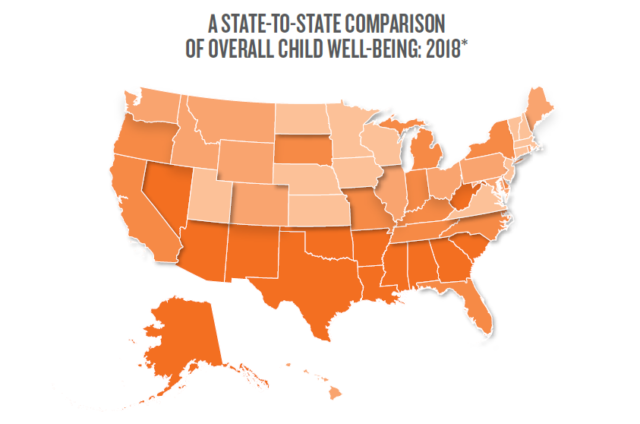
In 2012, Oklahoma’s overall children’s welfare ranking was 40th in the nation. Two years ago, we were up to 37th. Last week, the Annie E. Casey Foundation’s 2018 KIDS COUNT Data Book announced Oklahoma has slipped down to 44th in children’s welfare (full report embedded at the end of this article).
(Due to a change in measuring teen alcohol and drug abuse – one of 16-total metrics – the study warns against historical comparisons in terms of two categories: overall child well-being and health.)
Not all of the news is bad: National and Oklahoma teen birth rates are at an all-time low. Since 1990, national teen birth rates have dropped by two-thirds to a 2016 rate of 20 per 1,000 births. The Oklahoma rate of 33 per 1,000 is about two-thirds higher than the national rate. So, we’ve made great progress on that front (even though Oklahoma is tied with Mississippi for second-highest rate in the nation). We have even better news in terms of teen drinking, with only 4 percent of teens abusing alcohol.
Great Recession shadows economic attributes
Since the Great Recession, unemployment rates have fallen significantly, and health coverage has expanded. Because that most recent economic decline was worse than any time since the Great Depression, improvements for poor kids seem pretty modest. Nationally, the percentage of kids living in poverty has dropped 3 points to 19 percent, and the percentage of kids with parents who lack secure employment has declined by more than one-sixth, to 28 percent. The percentage of disconnected teens – out of school and unemployed – has dropped by two points to 7 percent.
Economic segregation has also improved somewhat as the Great Recession faded. The percentage of children in high-poverty neighborhoods declined to 13 percent, but an asterisk must be applied to that figure. The percentage of African-American children living in neighborhoods with extreme poverty is 30 percent, or six times worse than white kids.
Economic welfare is the metric where Oklahoma scores the highest: 36th place, just one spot below Texas. But this reveals a drop from 29th in 2016! Oklahoma’s rate of disconnected youth is more than 22 percent worse than the rest of the nation. Even in the category where our state scores the best, our numbers remain basically at the national levels of the worst economic downturn in 80 years.
How does Oklahoma measure up in the other categories?
Oklahoma dropped from 34th in the 2016 Health Index to 40th. The state’s rating had previously been bolstered by reductions in the rate of low birth weights and decreasing the number of families without insurance, however, Oklahoma’s child uninsured rate is the fifth-highest in the U.S., and we also have the seventh-highest rate of child and teen deaths.
Oklahoma is ranked 44th in Family and Community Indicators, down from 38th from two years ago. Despite the positive results due to teenagers making better choices, 35 percent of our kids are being raised in households with a single parent, and 15 percent of children are being raised in a home where the head of the household did not graduate from high school.
Early education not enough to offset deficiencies later
Which brings us to Oklahoma’s lowest ranking: 46th in education. It’s enough to make us long for the good old days of 2016, when we were four points higher. Due to our widely praised record in pioneering early education expansion, 43 percent of 3- and 4-year-olds were in pre-kindergarten according to the 2014-2016 report. (That metric also deserves an asterisk because it represents a decline in comparison with the rest of the nation.)
Once our children enter elementary school, we see the effects of the lack of funding. According to a very rigorous testing standard, in 2017, 71 percent of the state’s fourth-graders were not “proficient” in reading. In 2015, 67 percent did not meet the proficiency standard, and that was only two points below the national average. Although that metric holds states to a standard that is probably too high, the same cannot be said by our high school graduation rate: 18 percent of high school students did not graduate on time.
Budget cuts can’t fix great injustices
We need an evidence-based conversation about the causes of the state’s sorry record. Being a former historian, it’s hard for me to understand why free marketers still believe that tax cuts can produce trickle-down prosperity. Oklahoma cut taxes more than almost any other state, but we now lag further behind. Even true believers in supply-side economics would look in vain for evidence that Oklahoma’s tax cuts improved the quality of lives for poor families.
Oklahoma’s successes and tragedies are rooted in our history. Before tax cuts spun completely out of control, many state and nonprofit service providers did great work in many areas. For instance, during this century’s first decade, Oklahoma reduced group-home or institutional placements by more than 50 percent. By the end of the Great Recession, however, the state was tied for the worst in the nation, with 48 percent of children under 5 being maltreated.
Oklahoma is capable of creating great injustices as well as thoughtful solutions for our social problems. We can’t reverse the sins of the past and present, however, through extreme budget cutting.
